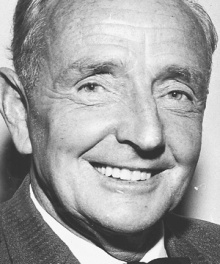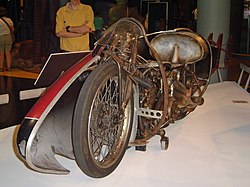
The Bonneville Salt Flats are a densely packed salt pan in Tooele County in northwestern Utah, United States. A remnant of the Pleistocene Lake Bonneville, it is the largest of many salt flats west of the Great Salt Lake. It is public land managed by the Bureau of Land Management and is known for land speed records at the Bonneville Speedway. Access to the Flats is open to the public.

Bonneville Speedway is an area of the Bonneville Salt Flats northeast of Wendover, Utah, that is marked out for motor sports. It is particularly noted as the venue for numerous land speed records. The Bonneville Salt Flats Race Track is listed on the National Register of Historic Places.

The World's Fastest Indian is a 2005 New Zealand biographical sports drama film based on the Invercargill, New Zealand speed bike racer Burt Munro and his highly modified 1920 Indian Scout motorcycle. Munro set numerous land speed records for motorcycles with engines less than 1,000 cc at the Bonneville Salt Flats in Utah in the late 1950s and into the 1960s. The film stars Anthony Hopkins, and was produced, written, and directed by Roger Donaldson.
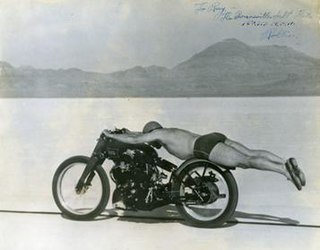
Roland Robert Free was an American motorcycle and automobile racer best known for breaking the American motorcycle land speed record in 1948 on the Bonneville Salt Flats, Utah. A picture of Free, prone and wearing a bathing suit, has been described as the most famous picture in motorcycling.
Dave Campos is a top-fuel drag motorcycle racer and held the motorcycle land speed record from 1990 until 2006.

Chris Carr is an American motorcycle dirt-track racer and seven-time winner of the A.M.A. Grand National Championship. He has also competed as a motorcycle road racer at the national level and was a motorcycle land speed world record holder.

The motorcycle land-speed record is the fastest speed achieved by a motorcycle on land. It is standardized as the speed over a course of fixed length, averaged over two runs in opposite directions. AMA National Land Speed Records requires two passes the same calendar day in opposite directions over a timed mile/kilometre while FIM Land Speed World Records require two passes in opposite directions to be over a timed mile/kilometre completed within two hours. These are special or modified motorcycles, distinct from the fastest production motorcycles. The first official FIM record was set in 1920, when Gene Walker rode an Indian on Daytona Beach at 104.12 mph (167.56 km/h). Since late 2010, the Ack Attack team has held the motorcycle land speed record at 376.36 mph (605.69 km/h).

Electric motorcycles and scooters are plug-in electric vehicles with two or three wheels. Power is supplied by a rechargeable battery that drives one or more electric motors. Electric scooters are distinguished from motorcycles by having a step-through frame, instead of being straddled. Electric bicycles are similar vehicles, distinguished by retaining the ability to be propelled by the rider pedaling in addition to battery propulsion.

David Abbott "Ab" Jenkins was the 24th mayor of Salt Lake City, Utah between 1940 and 1944. He was a professional race car driver. Jenkins' interest in motorsports began with racing motorcycles on dirt tracks and across country. He then became interested in land speed records at the Bonneville Salt Flats. He was instrumental in establishing Bonneville as a location for such events, and in attracting overseas drivers such as George Eyston and Sir Malcolm Campbell to compete there.

The Vincent Black Lightning was a Vincent-HRD motorcycle first built in September 1948 at the Vincent works in Great North Road, Stevenage, Hertfordshire, UK, and produced from 1948 to 1952. The bike was a purpose-built factory modified Black Shadow that was then named and produced as the Black Lightning. At the time the Black Lightning was the fastest production motorcycle in the world.
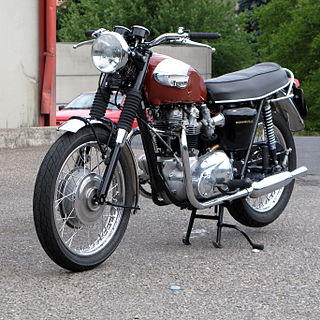
The Triumph Bonneville T120 is a motorcycle originally made by Triumph Engineering from 1959 to 1975. It was the first model of the Bonneville series, which was continued by Triumph Motorcycles Ltd. The T120 was discontinued in favour of the larger 750 cc T140 in the early 1970s.

The Indian Scout is a motorcycle built by the Indian Motocycle Company from 1920 to 1949. It rivaled the Chief as Indian's most important model. The 101 Scout, made from 1928 to 1931, has been called the best motorcycle Indian ever made. A second line of Scouts, with heavier frames, was introduced in 1932 alongside the Standard Scout, which replaced the 101 Scout and shared its frame with the Chief and the Four. The small-displacement Scout and the Sport Scout, introduced in 1934, were continued until the end of civilian production in 1942. Military versions of both models were used by US and other Allied forces during World War II.

The Triumph Tiger 110 is a British sports motorcycle that Triumph first made at their Coventry factory between 1953 and 1961. The T110 was developed from the Triumph Thunderbird and first appeared in 1954.
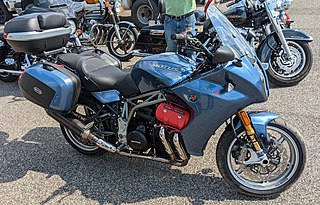
The Motus MST was a sport touring motorcycle produced from 2014 to 2018 by Motus Motorcycles of Birmingham, Alabama. Motus was the newest motorcycle manufacturer in the United States. Motus' partner in developing the MST was race car manufacturer Pratt & Miller, who were credited with product engineering, development, testing and validation for the MST.
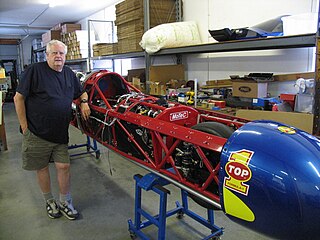
The TOP 1 Ack Attack is a specially constructed land-speed record streamliner motorcycle that, as of March 2013, has held the record for world's fastest motorcycle since recording a two-way average speed of 605.697 km/h (376.363 mph) on September 25, 2010, in the Cook Motorsports Top Speed Shootout at Bonneville Speedway, Utah. The Ack Attack's fastest one-way speed was officially recorded at 634.217 km/h (394.084 mph). This was the third time in four years the Ack Attack had broken the motorcycle land-speed record.

BUB Seven Streamliner is an American-built streamliner motorcycle that held the motorcycle land-speed record from 2006 to 2008 and again from 2009 to 2010. BUB Seven and two other streamliners traded the title of "world's fastest motorcycle" during official speed runs at Bonneville Speedway in the summer of 2006. The other two competitors were Ack Attack and the EZ-Hook streamliner. In 2017, Valerie Thompson rode BUB Seven for more record attempts at Bonneville.

Project '64 is the name of the attempt to break the car land speed record for vehicles with an engine capacity of between 751 cc and 1000 cc in a 1964 Mk1 Mini Cooper 970 S. The Project '64 team was successful in 2012, setting a record of 146.595 mph (235.922 km/h) at the SCTA Speed Week at Bonneville Salt Flats. The Project '64 team had planned to attempt to raise the record in 2014 and 2015. In 2014 their car was not complete in time to ship to Bonneville due to delays manufacturing specialist engine components and in 2015 Speed Week was cancelled due to poor track conditions. They now intend to compete at Speed Week 2016.
Denise Mueller-Korenek is an American cyclist. As of September 2018, she holds the world record for paced bicycle land speed and is considered "the fastest cyclist on earth". She set the record on September 16, 2018, at the Bonneville Salt Flats in Utah, by traveling an average of 183.932 mph (296.009 km/h) on a custom-built carbon KHS bicycle behind a custom-built vehicle to minimize air resistance. The previous record, 167 miles per hour (269 km/h), was set in 1995 by Dutchman Fred Rompelberg. Two years earlier she set the women's bicycle land speed record, pedaling 147.7 mph (237.7 km/h). She is the first and only woman in history to hold the world record, which was first established in 1899.

Bonneville Motorcycle Speed Trials (BMST) (AMA Land Speed Grand Championship / FIM Land Speed World Records) is a motorcycle land speed racing event, held annually at Bonneville Speedway, US. The event is sanctioned by American Motorcyclist Association (AMA) as the Land Speed Grand Championship and Fédération Internationale de Motocyclisme (FIM) as the FIM Land Speed World Records. AMA-certified US National Land Speed records, and FIM-certified Land Speed World Records are set at this event. The event features motorcycles ranging from 50-cc to 3000-cc, as well as electric classes.
Ralph Hudson was an American businessman and motorcycle racer who gained recognition for setting multiple AMA and FIM land-speed records at Bonneville between 2009 and 2020.
